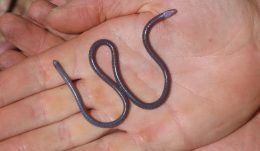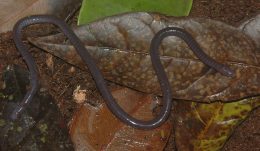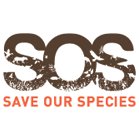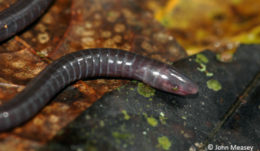- Locations: Sagalla Hill (Taita Hills - Eastern Arc Mountains), Kenya
- Active dates: 2011 - ongoing
Aims
To protect and expand remnant natural habitat across Sagalla Hill for the area’s threatened biodiversity and local communities, stop further environmental destruction and degradation and improve/enhance natural resource management. To reconnect poverty alleviation to biodiversity conservation in Kenya’s Eastern Arc Mountains
Species
Background
Despite its close resemblance to an earth worm, the Sagalla caecilian is actually a limbless amphibian. It spends most of its life below ground and is adapted for a burrowing lifestyle – its eyes are covered by a protective skin, it has a strong, bony skull for pushing through the soil, and possesses sensory tentacles either side of its head to detect the chemical signals from its prey. The Sagalla caecilian is only found in one small area in the south-east of Kenya – Sagalla Hill – which is around half the size of Manhattan Island. Poor rainfall seasons continue to pose a major challenge to the biodiversity and the local people of this area, and have an impact on many things including tree planting.
Actions
Removing Eucalyptus plantations and replacing them with native vegetation to stabilise the soil and prevent further erosion and desiccation
Developing sustainable livelihoods (e.g. fish farming schemes) to provide an income to local farmers as an alternative to draining wetlands and riverine valleys
Improving farming techniques to increase soil fertility and decrease soil erosion
Restoring vegetation along stream banks and on steep slopes in order to minimise erosion and loss of important soil habitat
Providing technical support visits to farmers, training bee-keeping and also training farmers to graft avocado seedlings.
Establish a support network and training in sustainable livelihoods
Training and supporting women’s groups in handicraft manufacture and marketing.
Create Community Forest Associations (CFAs) and Water Resource Users Associations (WRUAs) and locally led community groups.
Train community members, students and advisers in biodiversity conservation
Implement CEPA strategy
Implement the species action plans developed for the three Taita endemic species
Gallery



Achievements
6 tree nurseries are now in operation with involvement from locally led community groups
20 fishponds have been set up and 53 farmers have been trained in fish-farming during the project. An additional 70 farmers have been trained in bee-keeping, 13 farmers trained in carbon credits trading and 44 farmers trained in sustainable agriculture
The Mlilo Handicrafts groups were supplied with equipment and materials and have commenced production of various handicrafts, among them baskets, open shoes and other items
Farmer-to-farmer training took place in Taita where Tekida Bee-keepers group trained the Iyale Angamiza Jangwa Group on bee-keeping
46 community members were trained in biodiversity monitoring and materials/tools/equipment required for the same
The average annual income of participating households increased by at least 30% and diversified through inclusion of up to 6 additional sustainable alternative livelihood options
CEPA strategy activities were implemented including the participation of Project Officers in public meetings organised by community Chiefs and Assistant Chiefs to create awareness on environmental conservation and on the project activities
Species Action Plans (SAPs) have been developed and approved for the three Taita endemics (Taita Thrush, Taita Apalis and Sagalla Caecilian)
3 CFAs (Community Forest Associations) have been developed and registered
By the end of May 2017, over 290,519 seedlings had been raised and planted, which includes those planted by 184 farmers to enhance native forest connectivity between Iyale and Ngangao forests
Associated Fellows
Collaborators and Supporters
-

BBC Wildlife fund
-

Critical Ecosystem Partnership Fund
-

Conservation International
-

IUCN Save Our Species
-

Arizona State University
-

The Darwin Initiative
-

Taita Taveta Wildlife Forum
Related blog posts

Sagalla Caecilian Conservation Makes Significant Progress in Kenya
In Kenya, the Sagalla Caecilian Conservation Project is carrying out habitat rehabilitation through planting of indigenous trees and vetiva grass in Sagalla Hill forest,…

A great month for the livelihoods project in Sagalla
The alternative livelihoods project to secure a future for he Sagalla caecilian never stops… Tree planting The weather has favoured tree planting this month,…

Steps to reforestation in Sagalla, Kenya
The following blog update was sent by James Mwang’ombe of the Taita Taveta Wildlife Forum in Kenya, where EDGE Fellow Dorine is working to…

Saving Sagalla’s legless celebrity!
The EDGE Amphibians project has recently secured funding to start a conservation project for one of our highest priority species – the Sagalla caecilian…

Sagalla Forest Inventory
Forest Inventory and data collection in Sagalla Forest was done in the month of November 2009. Method The field plots were of size 50…